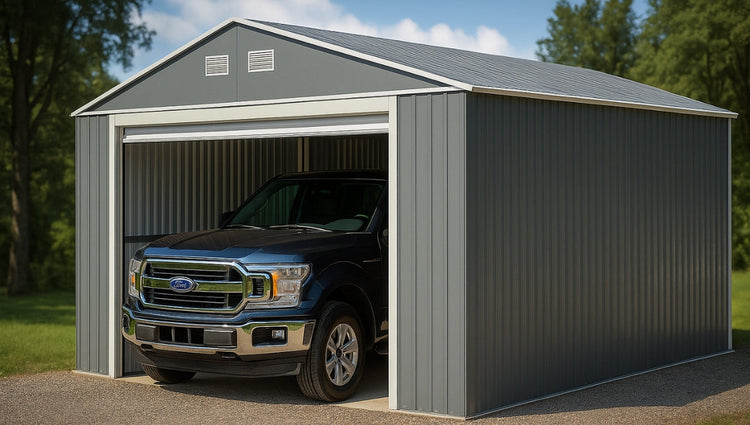
When planning a new garage or evaluating an existing one, one of the most common questions homeowners ask is: "What is the standard 2 car garage size?"
A standard two-car garage typically measures between 20x20 feet and 24x24 feet, though some homeowners choose larger layouts like 24x30 feet for extra space. The right size depends on your vehicles, storage needs, and lifestyle requirements.
Choosing the right garage size matters more than most people realize. A garage isn't just a place to park it's storage space, a workshop, and a feature that can boost your home's resale value significantly. In this complete guide, we'll cover common garage sizes, design considerations, layout ideas, and frequently asked questions so you can confidently plan your space and make the best investment for your property.
How Big Is a Standard 2 Car Garage?
While garages vary significantly across different regions and home styles, most two-car garages fall into three main categories that have become industry standards over decades of construction:
Minimum: 20x20 feet
A 20x20 garage is considered the smallest size that still qualifies as a 2 car garage. It can fit two compact cars side by side, but the maneuvering space will be tight. Once you park, there's little room for opening doors comfortably or adding meaningful storage solutions. For SUVs and trucks, this size is often frustrating and impractical for daily use.
This minimum size works best for urban areas where space is at a premium, or for homeowners who primarily drive smaller vehicles and don't require additional storage. However, many homeowners who start with this size eventually wish they had built larger.
Average: 24x24 feet
The 24x24 garage is the most common choice and provides a comfortable fit for two vehicles, including SUVs and midsize trucks. This size also allows space for shelving, bikes, or storage along the walls without making the garage feel cramped or difficult to navigate.
This dimension has become the sweet spot for most families because it balances functionality with cost-effectiveness. It provides enough room for modern vehicles while leaving space for the storage that most households need.
Larger: 24x30 feet or more
If you drive full-size pickup trucks, large SUVs, or simply want extra room for hobbies or a workshop, a 24x30 garage is ideal. It allows for easy parking, extra storage, and designated work zones without compromising vehicle access.
This larger size is becoming increasingly popular as vehicles continue to grow in size and homeowners seek multi-functional spaces that serve beyond just parking.
Other Common Sizes: 22x22 and 26x26
Some homeowners choose in-between options like 22x22 (slightly more comfortable than 20x20) or 26x26 (a luxury size with significant storage and workspace). These sizes offer customized solutions for specific needs and lot constraints.
For single-car applications or workshop spaces, smaller options like the Duramax 12x20 imperial metal garage dark gray or Duramax 12x20 imperial metal garage light gray provide excellent alternatives for homeowners with specific spatial or aesthetic requirements.


Comparison Table: Common 2 Car Garage Sizes
|
Size (Feet) |
Vehicle Fit |
Storage Space |
Best For |
|
20x20 |
Compact cars only |
Almost none |
Bare minimum |
|
22x22 |
Compact cars, small SUVs |
Limited storage |
Middle ground option |
|
24x24 |
Sedans, SUVs, light trucks |
Moderate storage |
Most popular choice |
|
24x30 |
Large SUVs, full-size trucks |
Ample space for storage/workshop |
Maximum flexibility |
|
26x26 |
Any vehicle combination |
Generous storage + flex space |
Premium garages |
Key Factors That Influence 2 Car Garage Dimensions
When planning a garage, it's not just about parking. Several critical factors influence what size will work best for your specific situation and long-term needs.
1. Vehicle Size and Type
Understanding your current and future vehicle needs is crucial for selecting the right standard 2 car garage size:
-
Compact cars: 6–6.5 feet wide, 14–16 feet long. Fit comfortably in a 20x20 garage.
-
SUVs and minivans: 7 feet wide, 16–18 feet long. Best accommodated in 22x22 or larger garages.
-
Pickup trucks: 8 feet wide, 20–22 feet long. Require 24x24 or larger for comfortable daily use.
Consider not just your current vehicles, but what you might drive in the future. Many families upgrade to larger vehicles over time, making it wise to plan ahead.
2. Storage Needs and Requirements
Most garages double as storage areas for tools, lawnmowers, bikes, seasonal decorations, or sports equipment. If you want more than just parking, a 24x24 or 24x30 provides the flexibility to accommodate these items without cluttering your parking area.
Think about your storage needs in categories: seasonal items, lawn and garden equipment, sporting goods, tools and hardware, and emergency supplies. Each category requires dedicated space that shouldn't interfere with vehicle access.
3. Lifestyle Additions and Multi-Use Functions
Some garages also serve as workshops, home gyms, hobby spaces, or even temporary office areas. If this applies to your situation, building bigger than the minimum standard becomes essential for functionality and comfort.
Consider whether you might want to use part of your garage for woodworking, car maintenance, exercise equipment, or seasonal activities that require protected space.
4. Future-Proofing and Technology Integration
Cars are getting larger overall, and more households are adding electric vehicles (EVs) that require charging stations and potentially different parking arrangements. Building with extra space today prevents costly modifications or expansions tomorrow.
Consider the space needed for EV charging equipment, potential car lifts for maintenance, or upgraded electrical systems that modern garages often require.
5. Building Codes and HOA Regulations
Check local building codes and homeowner association rules carefully. They may dictate how close to the property line your garage can sit, maximum height restrictions, or architectural style requirements that impact your standard 2 car garage size choices.
Some areas have specific requirements for setbacks, drainage, or fire safety that can influence the practical dimensions of your garage project.
For a full comparison of 1, 2, 3, and 4 car garages, read our complete guide: What Is the Standard Garage Size (1, 2, 3, 4 Cars)?
Standard 2 Car Garage Door Dimensions
Your garage doors will determine how easily you can access your space and significantly impact both functionality and curb appeal.
Door Configuration Options
Double Door (Most Common): 16 feet wide by 7 feet tall. This single large door fits two cars side by side and provides maximum opening width for maneuvering larger vehicles.
Two Single Doors: 8–9 feet wide by 7 feet tall each. This configuration offers flexibility if your vehicles are different sizes or if one bay is used primarily for storage.
Height Considerations
Standard Height: 7 feet tall works for most passenger vehicles, but can feel tight for larger SUVs or trucks.
Recommended Height: 8 feet is increasingly popular and recommended if you own larger SUVs, lifted trucks, or want to accommodate future vehicle purchases.
Premium Height: 9+ feet allows for high-clearance vehicles and creates a more spacious feel inside the garage.
General rule: Leave at least 2.5–3 feet clearance on each side of a parked vehicle for opening doors comfortably and walking around the vehicle safely.
Optimal Standard 2 Car Garage Size for Different Vehicle Combinations
Choosing the right standard 2 car garage size becomes easier when you consider specific vehicle combinations that your family might use:
Compact Car + Sedan Combination
A 22x22 garage provides adequate space for this combination, with room for basic storage along the walls. This size works well for urban families or those with minimal storage needs. For smaller lots or budget-conscious homeowners, the Duramax 12x26 imperial metal garage light gray or Duramax 12x26 imperial metal garage dark gray offer practical solutions that can accommodate one vehicle plus significant storage space.


SUV + SUV Combination
A 24x24 garage is the minimum recommended size for two SUVs, providing enough space for door clearance and basic storage. For comfort and additional storage, consider 24x30.
Truck + Car Combination
A 24x30 garage handles this combination best, as full-size trucks require significant length, and the mixed vehicle sizes benefit from extra maneuvering room.
Two Full-Size Trucks
For two large pickup trucks, a 26x30 or larger garage ensures comfortable parking and adequate door clearance. This combination requires the most space of common vehicle pairings.
Layout, Design & Practical Uses
A 2 car garage isn't just a box, it can be thoughtfully designed around your specific needs and lifestyle requirements.
Layout Options for Maximum Functionality
Parking Only: Purely functional design, best for smaller garages where space is at a premium. Focus on efficient traffic flow and minimal obstructions.
Parking + Storage: Add shelving systems or cabinets along walls to maximize vertical storage while maintaining vehicle access.
Parking + Workshop: Dedicate a corner or wall section for a workbench and tool storage, creating a functional workspace that doesn't interfere with parking.
Flex Layout: Large garages (24x30+) allow multiple defined zones: dedicated parking areas, organized storage sections, and hobby or workshop use areas.
Attached vs Detached Considerations
Attached garages offer convenience for bad weather access and easy transition between home and vehicles. They're typically more cost-effective to build and can share utilities with the main house.
Detached garages provide more design freedom, reduce noise transfer to living spaces, and can double as backyard workshops or entertainment spaces without impacting the main house. For those considering prefab options, the Imperial Garage series offers durable metal construction that's perfect for detached garage applications.
Modern Lifestyle Uses
More homeowners are converting portions of their garages into multi-purpose spaces—from home gyms and yoga studios to game rooms, workshops, or even temporary offices. Larger dimensions make this flexibility possible without sacrificing essential vehicle storage space.
Consider how your garage might need to adapt over time as your family's needs change, children grow, or work-from-home requirements evolve.
Regional & Climate Considerations
Where you live significantly impacts how you should design your garage and influences the optimal standard 2 car garage size for your specific situation.
Cold Climate Adaptations
Insulation requirements: Proper insulation keeps vehicles warmer and makes the space more comfortable for storage access during the winter months.
Heated flooring options: Radiant floor heating prevents ice buildup and makes winter vehicle maintenance more pleasant.
Snow load considerations: Roof structure must accommodate regional snow loads, which may require additional structural support.
Hot Climate Modifications
Ventilation systems: Proper air circulation prevents excessive heat buildup that can damage stored items and make the space uncomfortable.
Radiant barriers: Reflective roofing materials help reduce heat transfer into the garage space.
Cooling considerations: Some homeowners add fans or air conditioning for garages used as workshops or hobby spaces.
Wet Climate Protections
Moisture control systems: Dehumidification and proper drainage prevent mold, mildew, and vehicle corrosion.
Sealed foundations: Waterproof foundation systems prevent ground moisture from entering the garage space.
Drainage planning: Proper grading and drainage systems protect both the garage structure and stored items.
By factoring in climate considerations during the planning phase, your garage will remain comfortable, functional, and durable for decades of use.
Foundation Options for a 2 Car Garage
A garage is only as good as its foundation, and several options exist, each with specific advantages and trade-offs for different situations and budgets:
Concrete Slab Foundation
The most durable and stable option, though also the most expensive initially. Concrete provides excellent long-term value and can support heavy vehicles, equipment, and storage loads indefinitely. Ideal for garages you plan to keep for decades and for areas with challenging soil conditions.
Packed Gravel Base
A more budget-friendly choice that's quicker to install than concrete, while still providing adequate support when properly prepared and leveled. This option works well for areas with stable soil and can be upgraded later if needed.
Paver Stone Systems
Attractive and moderately priced, though less stable than concrete for heavy loads. Suitable for lighter structures or situations where visual appeal is important. Pavers allow for easier utility access and modifications over time.
Treated Lumber Runners
The most cost-effective foundation option, best suited for smaller garages or temporary structures. Requires more maintenance over time but offers the lowest initial investment.
Regardless of the material chosen, the key to any successful garage foundation is creating a solid, properly leveled surface that ensures long-term structural stability and prevents settling issues.
Cost & Value of a 2 Car Garage
While costs vary significantly by region, materials, and features, understanding the relative investment levels helps in planning your standard 2 car garage size project:
Investment Levels by Size
Basic build (20x20): Most budget-friendly option with minimal storage capacity. Best for homeowners focused on basic vehicle protection at the lowest initial cost.
Standard (24x24): Represents a balanced investment offering good value with adequate space for parking and storage needs of most families.
Premium (24x30+): Higher upfront investment but provides maximum flexibility, comfort, and long-term utility. Often, the best value for families is to stay in their homes long-term.
Return on Investment Considerations
A well-designed garage can significantly improve your home's resale appeal and market value. Most buyers expect at least a 2 car garage, and larger, well-organized garages stand out positively in competitive markets.
The investment in a larger garage often pays dividends through increased home value, improved daily functionality, and enhanced storage solutions that reduce clutter in living spaces.
Future-Proofing & Smart Garage Planning
Think ahead to ensure your garage remains functional and valuable for years to come, regardless of how technology and transportation evolve.
Electric Vehicle Preparation
EV Charging Stations: Install appropriate electrical capacity and outlets now, even if you don't currently own an electric vehicle. This preparation is much less expensive during initial construction.
Electrical capacity: Ensure your electrical panel and garage wiring can handle the increased load of EV charging systems.
Vertical Space Utilization
Higher Ceilings (10–12 feet): Allow for car lifts, overhead storage racks, and improved air circulation. The additional cost during construction is minimal compared to later modifications.
Storage systems: Plan for overhead storage solutions that don't interfere with door operation or vehicle access.
Smart Technology Integration
WiFi garage door openers: Enable remote monitoring and control from smartphones, plus integration with home security systems.
Security cameras: Protect both vehicles and stored items while monitoring garage access.
Automated lighting: Motion-activated LED systems improve safety and energy efficiency.
Climate control: Pre-wire for fans, heating, or air conditioning that might be added later for workshop or hobby use.
FAQs About Standard 2 Car Garage Size
1. What is the most common size of a 2 car garage?
The most common standard 2 car garage size is 24x24 feet, which offers comfortable space for two vehicles and moderate storage capacity for most families.
2. Is 20x20 considered a 2 car garage?
Yes, 20x20 qualifies as a 2 car garage, but it's the absolute minimum size. SUVs and trucks will feel cramped, and storage space is extremely limited.
3. What is the standard garage door opening for 2 cars?
Typically 16x7 feet for a single double door, or two separate 8x7 doors. Many newer garages use 8-foot-tall doors for improved clearance.
4. What can fit in a 24x24 garage?
Two SUVs or light trucks plus wall-mounted shelving, bicycles, and basic storage systems without feeling crowded.
5. Is it better to build bigger than the standard size?
Generally yes. Most homeowners regret building too small rather than too large. The additional cost during construction is usually much less than expanding later.
6. Can a 2 car garage fit 2 trucks or SUVs?
A 24x24 works for most SUVs, but full-size trucks are more comfortable and practical in a 24x30 or larger garage.
7. What is the ideal depth for a 2 car garage with storage?
At least 24 feet deep, to leave adequate room in front of parked vehicles for walking and storage access.
8. Is 22x22 a good garage size?
It's a reasonable middle ground between minimum and standard sizes, offering slightly more comfort than 20x20 but with limited storage space.
9. What ceiling height is best for a 2 car garage?
A minimum of 8 feet works for most vehicles, but 10–12 feet allows for overhead storage, car lifts, and improved functionality.
10. What's the difference between attached and detached 2 car garages?
Attached garages offer convenience and weather protection for home access, while detached garages provide more design flexibility and can serve as dedicated workshop spaces.
Conclusion
A standard 2 car garage size typically ranges from 20x20 feet to 24x24 feet, with larger options like 24x30 feet providing maximum comfort and long-term flexibility. The right choice depends on your current vehicles, storage requirements, and long-term plans for the space.
When planning your garage, consider not just today's needs but how your requirements might change over time. Vehicles are getting larger, storage needs tend to increase, and many families discover additional uses for their garage space that weren't originally planned.
The investment in choosing the right standard 2 car garage size pays dividends through improved daily functionality, better home value, and the flexibility to adapt to changing needs without costly modifications.
If you're still exploring options, check out our full breakdown of standard garage sizes for 1–4 cars to compare all available options.
When in doubt, remember this key principle: it's always better to plan a little bigger now than to wish you had more space later. The modest additional investment during construction will provide benefits for decades to come.








